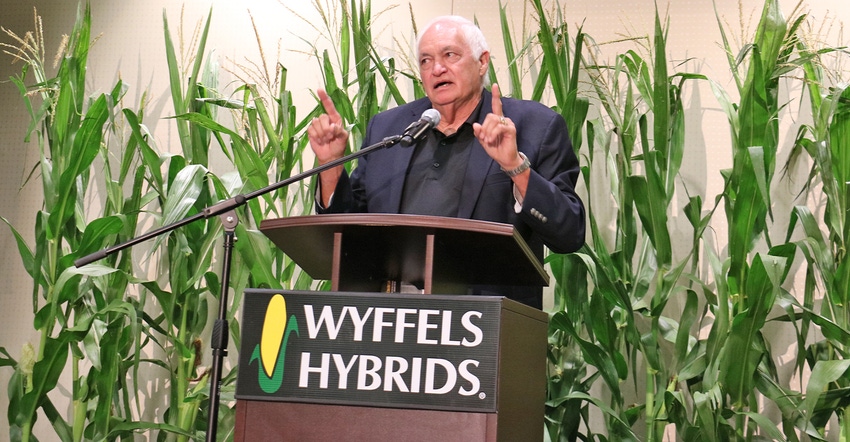August 9, 2019

By Dan Lemke
While the 1969 Apollo 11 mission was a monumental feat, noted agriculture futurist Lowell Catlett is more impressed by what American farmers have done in the 50 years since that momentous moon landing.
“I don’t think you understand the power of what you’ve done in these 50 years,” Catlett told the crowd of farmers attending Wyffels Hybrids 2019 Corn Strategies event July in Worthington, Minn. “In 1969, the world couldn’t feed itself. The population has doubled since 1969 and we still produce enough for 3,200 calories per person per day. We fed a hungry world.”
To understand the magnitude of what farmers have accomplished, Catlett, a retired agricultural economics professor and dean of the College of Agricultural, Consumer and Environmental Sciences at New Mexico State University, said it’s important to understand the context of how the world has changed in 50 years.
The U.S. had about 200 million people in 1969. Back then, 10% didn’t have a flush toilet and only 25% of the population had a phone. Families spent about 15% of their income on food. On average, families ate one meal at a restaurant every two weeks, according to Catlett.
Today, there are more than 330 million people in the country and most households have two phones. Nearly every other meal is eaten at a restaurant, yet Americans still spend less than 10% of their income on food. At the same time, the life expectancy of both men and women has increased by about 8 years.
According to Catlett, the nation’s average corn yield per acre in 1969 was 75 bushels. Today it’s 175. Farmers are also feeding 95 million cattle, 75 million pigs, 10 billion chickens and 90 million turkeys.
“We’re producing two-and-a-half times more on fewer acres,” Catlett said. “The efficiency of pounds produced in animal agriculture is up 50% and we’re doing it with 25% fewer inputs. There are 330 million Americans, yet the American farmer produces enough to export 25% of what we grow and feed an additional 250 million people worldwide. We often talk about feeding a hungry world — get over it. We’ve already done it.”
Catlett is a consultant to USDA, as well as the departments of the Interior, Defense and Labor. He has also served as a consultant to many Fortune 500 companies.
Rapid progress
As much as modern agriculture has changed and improved in the past, Catlett expects more rapid evolution in the future, even with the amount of farmed land shrinking in most states.
“We’re not going back to more acres. Scientific agriculture is how we’ll continue to feed the world,” Catlett said.
Catlett expects farming below the surface to become increasingly important for agriculture. Carbon sequestration and focusing on soil microbe counts will impact productivity. Catlett said laser-induced breakdown spectroscopy technology is used to measure elemental concentrations. The technology is used by the space rover Curiosity on Mars to test for the presence of water. It soon could be used to help farmers learn more about their soil health and crop pressures.
“It’s being used at New Mexico State University to look at cotton fields to identify insects and nutrient deficiency,” Catlett said.
Artificial intelligence and facial recognition are currently being used to monitor livestock health. Because technology can watch animals around the clock, potential health problems can be identified quickly.
“That can also be used to examine stress on plants,” Catlett said. “To us plants may look the same, but to technology, each plant looks different.”
Technology isn’t the only area where agriculture will likely change. Catlett said the concept of one health, where human health is directly impacted by the health of the animal population, will also have an effect. He said agriculture is more than feeding the world — it’s just as much a part of the ecology and the environment.
That concept is leading to what Catlett called farm-centric housing subdivisions. He said research shows most people want to be near plants and animals. Research from around the world indicates that humans are healthier when they interact with plants and animals, according to Catlett.
“Agriculture is what the world needs now more than ever,” he said.
Lemke writes from Madison Lake, Minn.
You May Also Like




